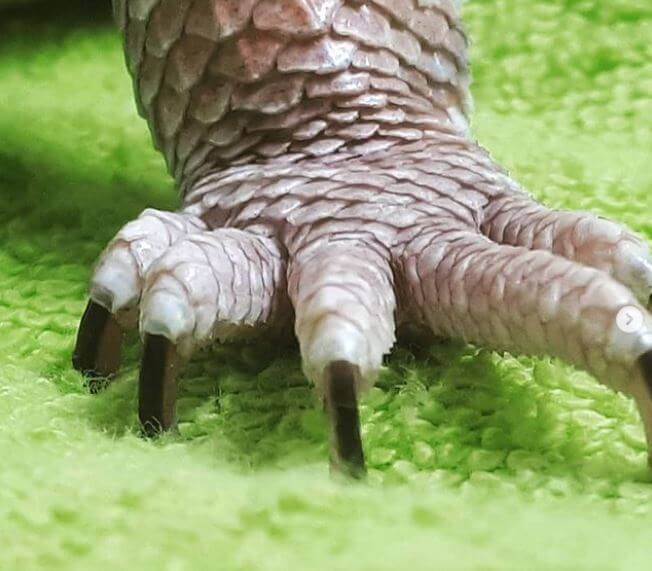For some reason, many owners do not know how often to trim bearded dragon nails.
Clipping the bearded dragon’s fingernails at the right time keeps the pins in the best condition, and they still can grab food if needed, yet does not destroy your furniture.
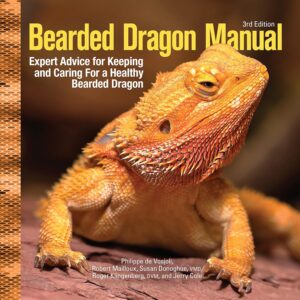 If you are considering the problem, scroll down to have more information about how often to trim bearded dragon nails!
If you are considering the problem, scroll down to have more information about how often to trim bearded dragon nails!
Related Posts:
- Reasons Why Your Beardie Turned White and Died
- Can Beardies Eat Radish Greens?
- Can Beardies Eat Rosemary?
- Beardie Body Language: How to Figure Out?
- Dunner Beardie vs. Normal Beardie: Facts and Differences
- Can Beardies Eat Peas?
- Can Beardie Eat Squash?
- Why Does My Beardie Stare at Me?
How Often to Trim Bearded Dragon Nails?
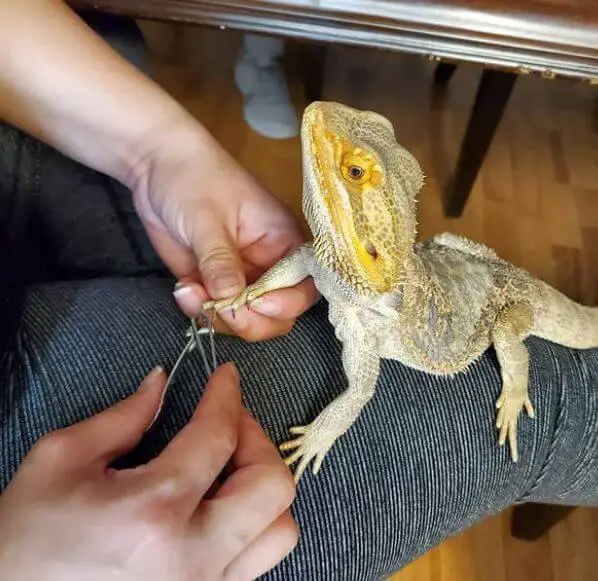
Primarily, you should trim the toenails around two to four times a year.
That said, after roughly four to six months, you can notice the bearded dragon nail is too long.
Moreover, the trimming frequency depends on how fast the nails grow.
There are some signals for you to see when to clip a bearded dragon’s claws.
1. An Ingrown Nail
When they develop too long, there would be some curling. The ingrown claws can make your pets annoyed or even hurt.
Therefore, try to notice and take care of the claws as often as you can.
A lot of owners try their best to trim the nails twice to three times annually.
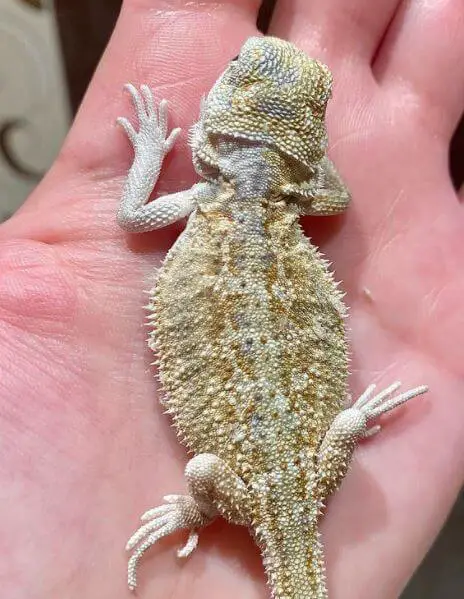
But some even do more, around five to six times.
That mostly depends on your free time and energy. It is also up to how quickly those nails’ length increases.
Bear in mind to notice the claws after a few months of trimming.
2. Scratching Nails
Secondly, users should keep an eye on the scratching nails.
That means bearded dragons’ overgrown nails could hurt you.
If you do not frequently put your beardies on your palms, think about glancing at their feet.
Have it been done, you might not have to worry about torn or worn pieces of furniture or rugs as well.
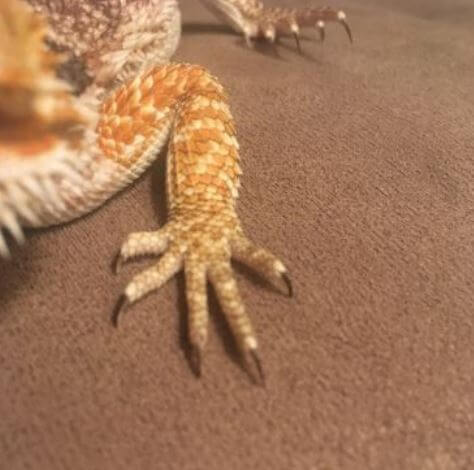
Why Should I Clip Bearded Dragon Claws?
There are many reasons why you should clip the bearded dragon’s snagged nails. The first explanation is to protect yourself.
When holding or playing with the beardies, the long claws can puncture and make your hand blooded.
Moreover, like human beings, such too-long draggers could become obstacles instead of helpers to move and climb.
Often, typical claws have to be perpendicular to the ground surface to make beardies walk, run, or dig smoothly.
When they have not been clipped for a long time, they twist over and cause trouble.

Besides, bearded dragons develop intense curiosity.
They love wandering, climbing, or even bathing on high branches. Uncomfortable-length nails might stop them from either their favorite activities or being stationary.
What’s more, unless you want to see your pets stuck on things, you have to cut their sharp and frustrated toenails frequently.
It is also hard for the nails to grow back after being ripped off incidentally.
How to Clip Bearded Dragon’s Claws Accurately?
1. Purchase the Required Materials
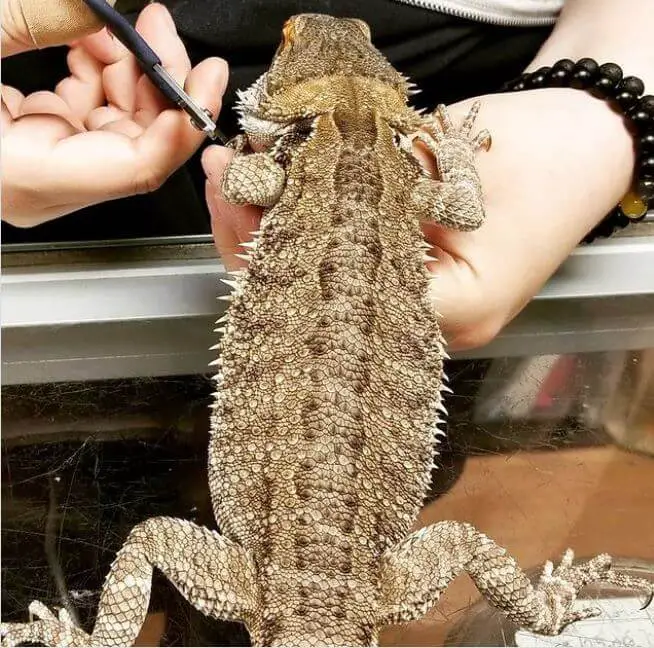
After understanding how often to trim bearded dragon nails, you should know what you need for accurately trimming bearded dragon claws.
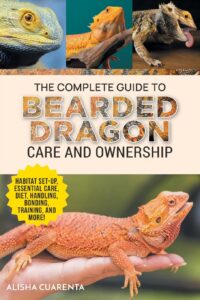 Pet shops or websites easily persuade many owners to buy luxury yet ineffective pet nail trimmers for their beardies.
Pet shops or websites easily persuade many owners to buy luxury yet ineffective pet nail trimmers for their beardies.
While the investment is not wrong, there’s no need to pay for such things except in unavoidable situations.
For instance, if it has been a long time since you last trim your bearded dragon claws, you might need a specific clipper for them because the nails become too long and thick to be cut off with typical human clippers.
Moreover, a few bearded dragons are too large, at around the 25” mark, so an average toenail trimmer is not suitable. That’s when you should spend your money.
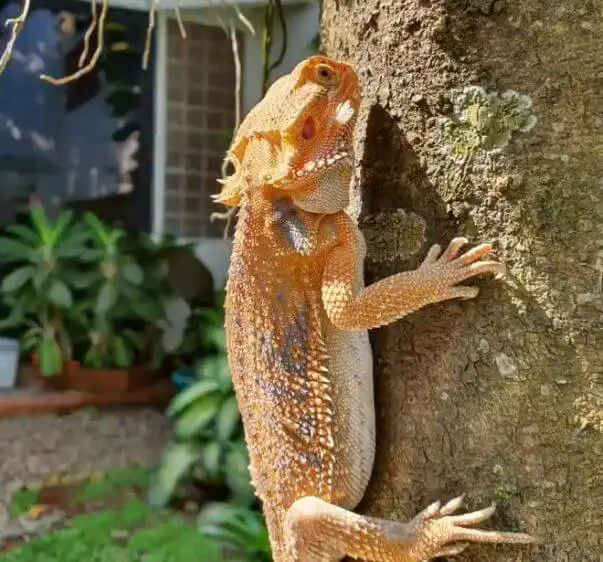
What’s more, you might need a cup of alcohol to clean the trimmers after manicuring the bearded dragon’s nails. Some pets have bacteria living on claws, especially when they eat other animals.
As a result, being careful and hygienic tools are essential.
Many owners even spend on a separate pair of trimmers for the small guys. That’s a good idea, especially in the current century full of diseases related to animals.
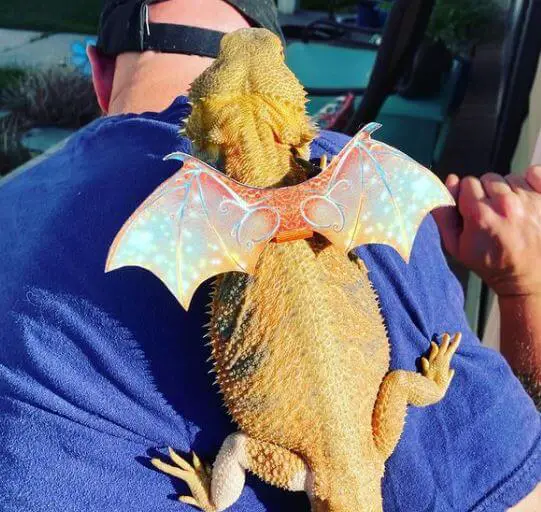
Furthermore, it is highly recommended to prepare styptic pencils or powder before trimming, especially with inexperienced ones.
The tools are for stopping bearded dragon nail bleeding and clotting blood. I hope you do not have to use them.
But “every day is not Sunday.” You never know what would happen in the process. For example, some owners commented that they cut the pet’s nails too close to its toes, making them bleed.
So prepare as carefully as you can. A good watch prevents misfortune.
2. Ensure Your Bearded Dragon Is Ready
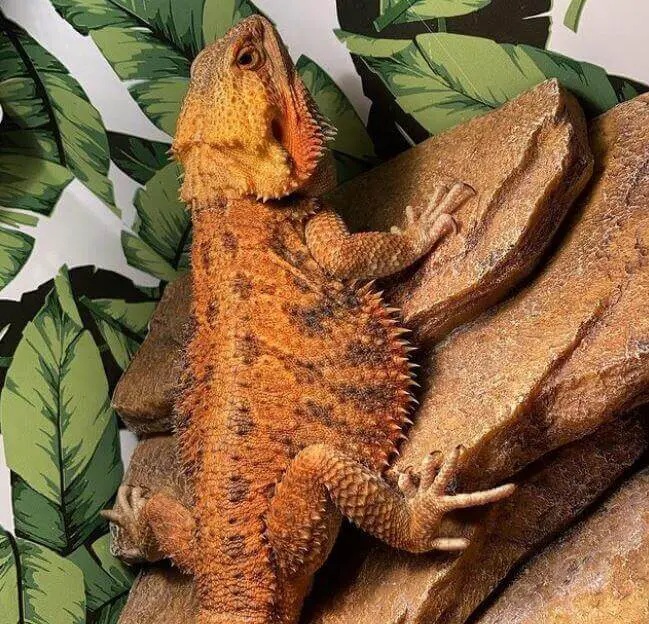
While some bearded dragons are relatively docile, some are restive with trimming their nails.
That might be because they do not want to be held, or they think it is lunchtime and they try to find the food.
For whatever reason, your bearded dragons are not ready to make up their nails. Accordingly, it would be best if you use some helpful tips below to solve the problem.
a. Choose Another Time
Instead of struggling with the bearded dragon, you can try another suitable time.
As usual, she is a gentle type of reptile. Therefore, it is relatively easy to trim her nails when she is ready for your demand.

For instance, you can try when she is sleeping at night or during her bathing time.
She might be either unconscious or too lazy to pay much heed to the trimming.
b. Try a Towel
Alternatively, if you are too busy waiting for another chance, try a soft and warm towel.
Use the towel to wrap your beardies up like a tiny fake shelter. The method also works well when you need to bath them.
3. Handle Your Bearded Dragon Frequently
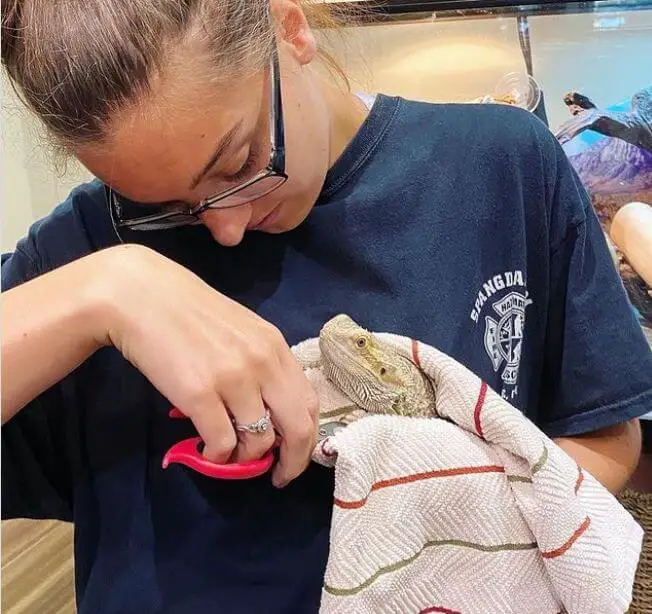
Think about handling your pet regularly on account of successfully clipping the claws.
A lot of bearded dragons wriggle or squirm when their claws are clipped.
To address the problem, you can train and handle them regularly to become more obedient. Once you do that, they might get used to being taken and show no dislike for manicuring.
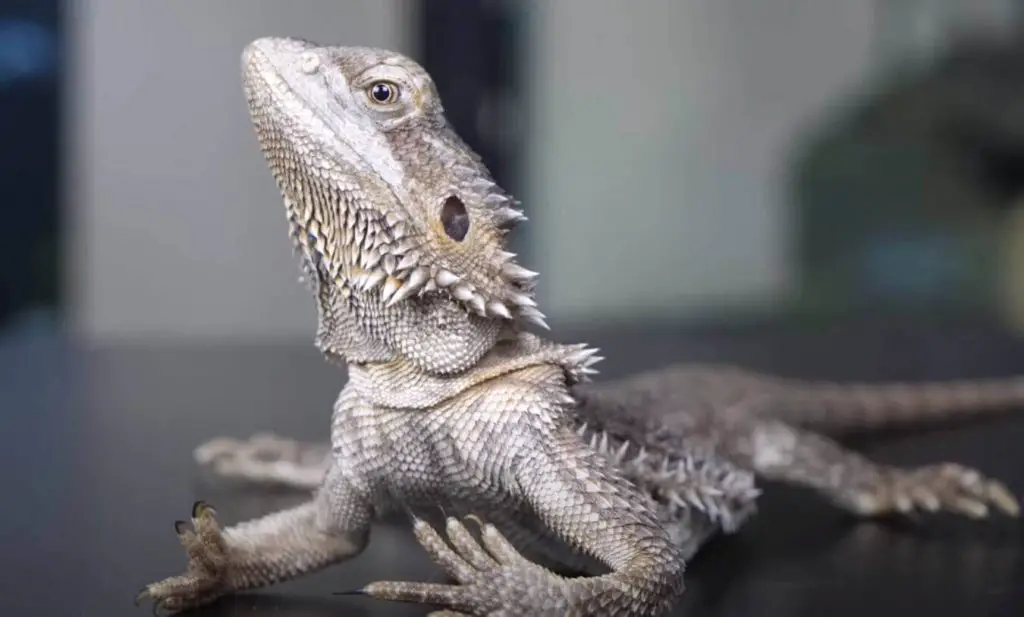
By contrast, when they realized you want to take them to the bath, the vet, or trimming their nail, they might end up being disobedient.
For instance, some people only cuddle or handle their pets when it comes to those hygiene activities. That results in a skittish action.
Moreover, it is suggested to play with the small reptiles as usually as you can.
As small kids, the tiny animals need to be taken care of frequently. After a short time, you will soon have a well-behaved pet that fully believes in you.
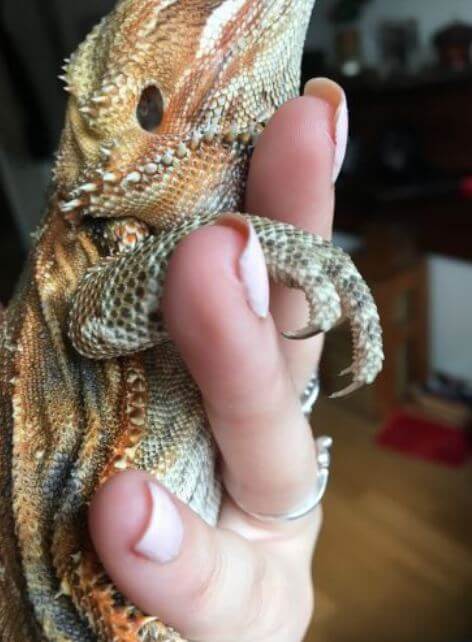
4. How Many People You Need
Typically, it requires only one to two people to do the clipping process.
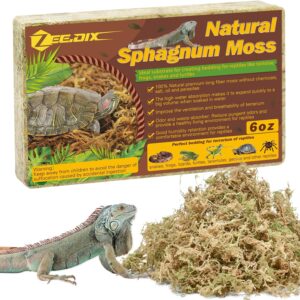 Especially with a calm and gentle guy, you only need one hand to hold him firmly and one to clip his long claws.
Especially with a calm and gentle guy, you only need one hand to hold him firmly and one to clip his long claws.
Beardies rarely pull their feet or move away.
Besides, if he is too big for one person to hold or often wriggles, you might need two people. One has him in their arms, and one clips his fingernails.
There is no such general rule in that field.
You only need to know that long claws can hurt you, so save yourself first. After that, think about your beardie’s safety and feelings as the second priority.
5. Should You Hold or Not?
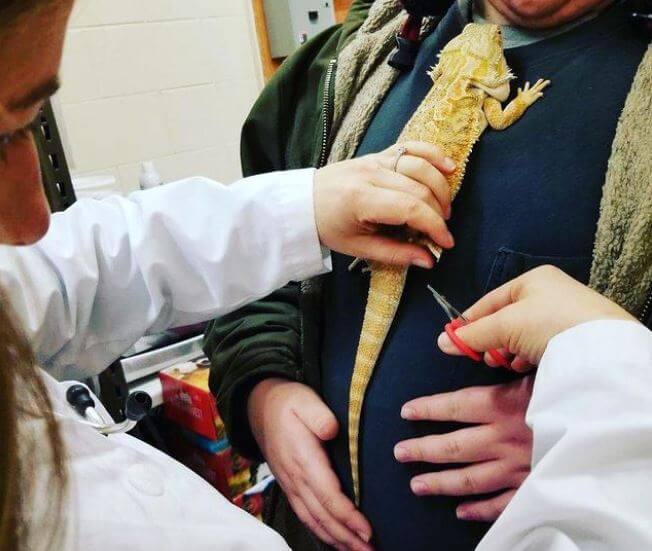
Once you understand how often to trim bearded dragon nails, you do need to know different beardies will show distinct behaviors when being cut.
Often, many quiet beardies love lying on your lap and letting you grab their tiny feet while clipping redundant draggers.
However, with some naughty guys, you should hold them firmly with one hand and clip claws with the other. Bearded dragons appear to be calmer when being kept in one fixed position.
Moreover, holding them helps you isolate squirming legs, ceasing the chance either of you is hurt.
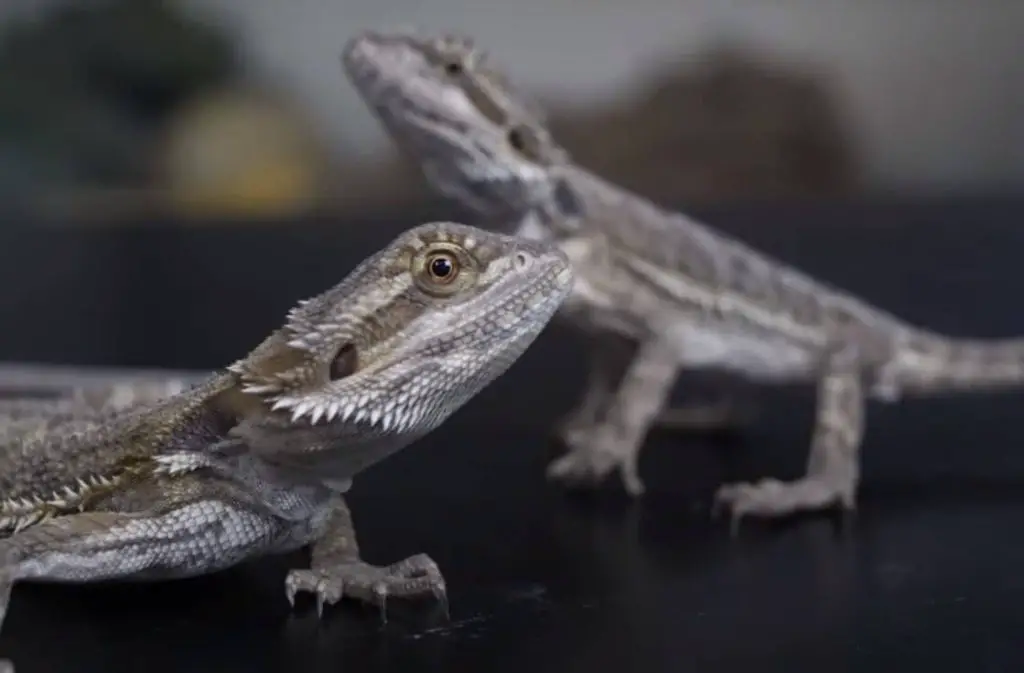
While holding them, keep in mind to have one of their legs between your fingers. That prevents them from pulling away or nipping at you.
Furthermore, the method plays an essential role in having access to small claws quickly.
Last but not least, you should put the little dragon on a flat and large surface such as the table or the ground.
The suitable place for trimming would ultimately secure him when he wants to escape or run.
6. Know Which Parts of the Claws to Trim
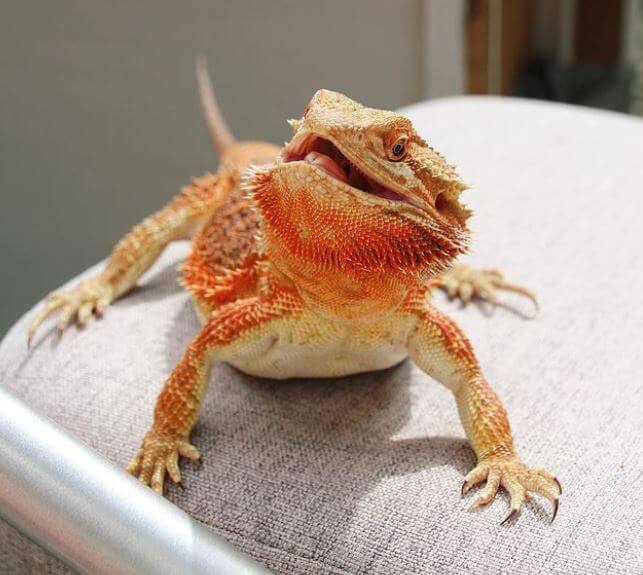
Like other animals, there are four main parts in beardie nails: a quick, pigment, bump, and tip.
For more details, keratin is the primary material making up those claws. It is relatively similar to human toenails.
There is a strip of pigment running across the top of the nail.
The stripe is often dark. However, due to the different physical traits and breeds, there might be some morphs appearing. They have all clear nails.
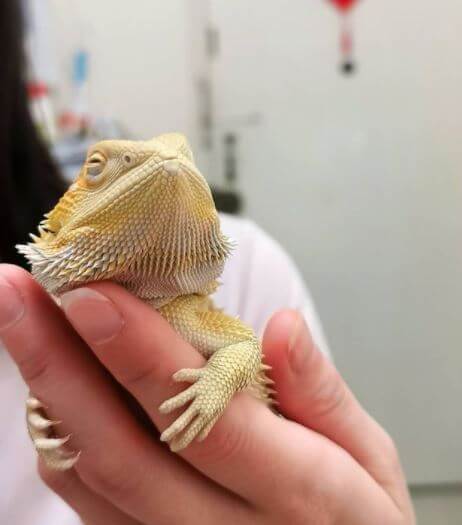
Therefore, when you cut the claws, notice the pigment. They are easier to detect, and they have colors as well.
Continuing with the pigment is the tip of a nail.
It is the sharp part that makes your beardies move hard after a long time of not being trimmed.
The bump lies underneath the nail, making it seem thicker.
There is a layer of tissue developing in the bump, which is called a quick. You have to stay away from the part while trimming.
7. Start Trimming Those Parts of the Claw
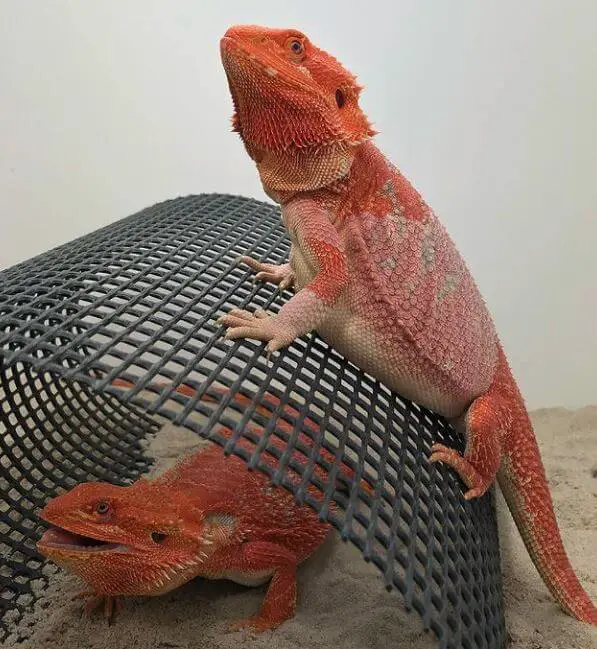
Keep in mind that our sole aim is to cut the tip shorter and avoid hurting other parts. Starting halfway from the end to the bump is an ideal choice.
If your trimming position is closer to the nails’ ending, it might become useless due to its length and thinness.
Besides, a position that is too near the bump can hurt your pet quickly.
The cat and dog owners often want to trim their pet toenails as short as possible.
The aim is to make it look nice and tidy. However, the goal does not fit bearded dragon claws.
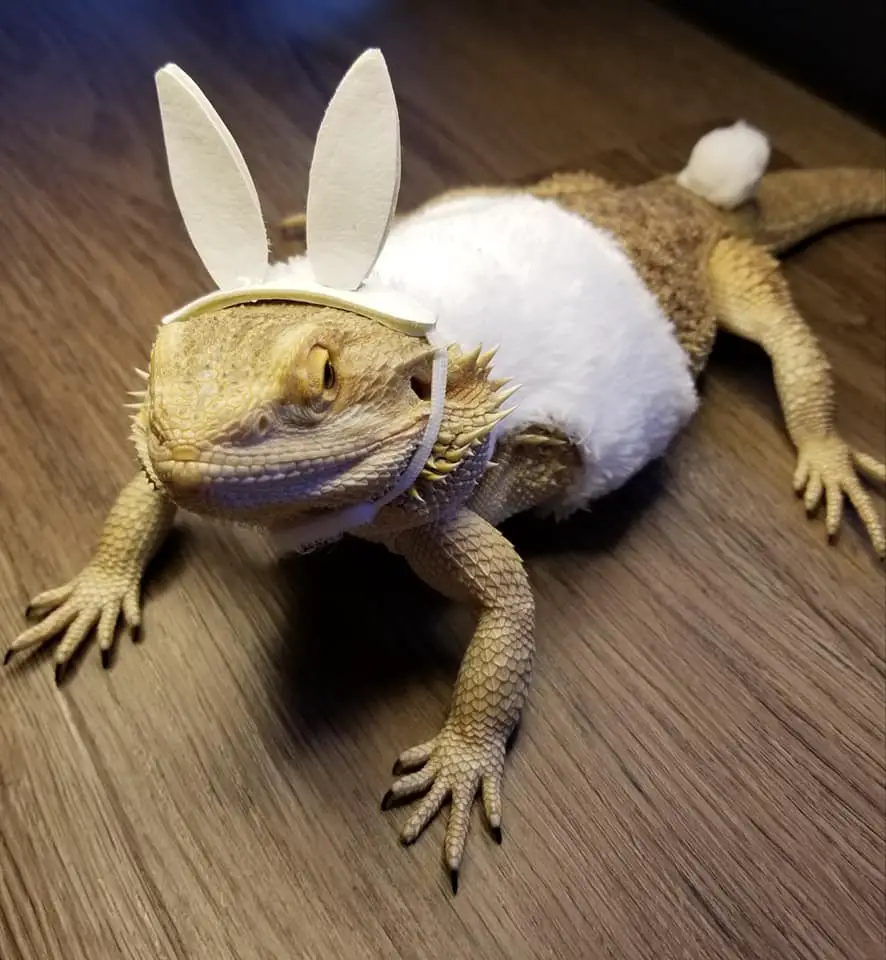
After already having cut the draggers off, consider rewarding your pets.
You can use their favorite food, such as hornworms. The action can lead to a more straightforward trimming process following times.
Moreover, if your bearded dragon appears to be bleeding, even just a little bit, use a blood clotting gel immediately.
Slightly put the powder around the toes, and the blood would shortly stop.
In the end, try to help the little guy relax with a warm cage or a piece of fruit.
Let’s take a look at this video to know more about how to clip a bearded dragon’s claws:
Frequently Asked Questions About How Often to Trim Bearded Dragon Nails
1. What to Do With the Bearded Dragon’s Dead Nail?
One of the helpful tips to solve the dead toenails is using raw honey.
Take roughly half of a spoon of raw honey and rub it around its toes. It would help if you spent it until the claw fell off and turning black.
2. Can You File a Bearded Dragon’s Toenails?
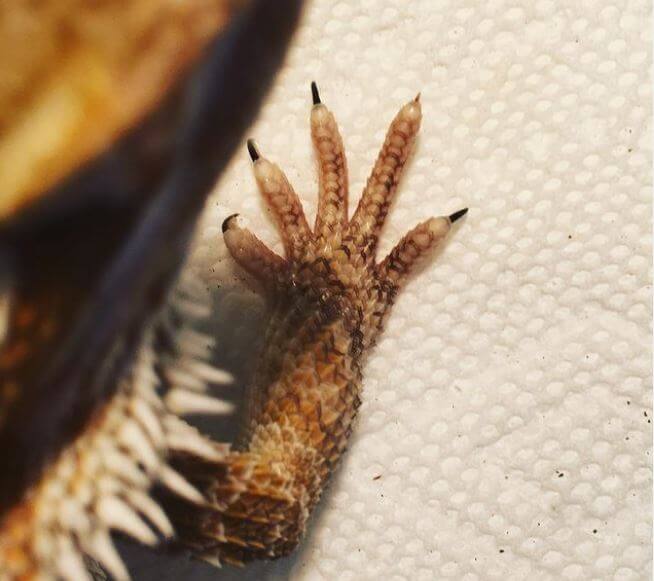
If the claws are too sharp, you can use the nail file to cut the edge off. However, it might take a long time and energy.
Besides, some naughty beardies may not like the slow and complicated technique, so it is more suitable for well-behaved ones.
3. Should You Trim Your Bearded Dragon’s Toenails?
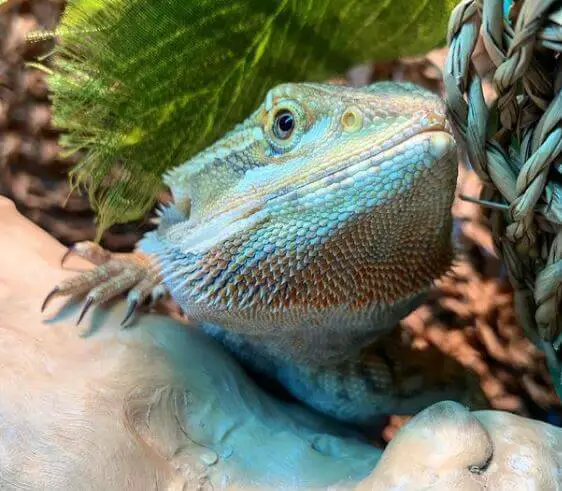
Of course, once she has claws, she always wants to trim those frustrating long parts. In the wild, beardies can cut off their feet by themselves when hunting prey.
However, when they are pets, they often are too lazy and lack opportunities to trim themselves.
4. Are My Bearded Dragon’s Claws Too Long?
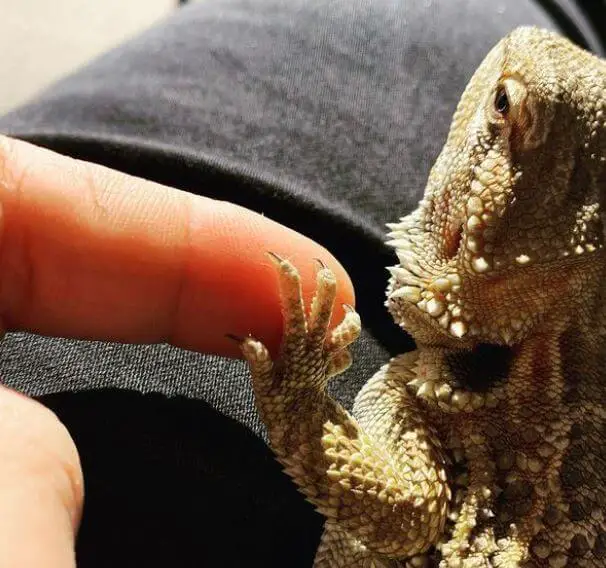
As I have just mentioned, a bearded dragon nail becomes too long when it hurt you. A suitable set of pins have to be perpendicular to the flat ground and stay upright.
If not, they can make trouble and stop your pets from going moving or climbing.
5. Why Did My Bearded Dragon Lose Nail?
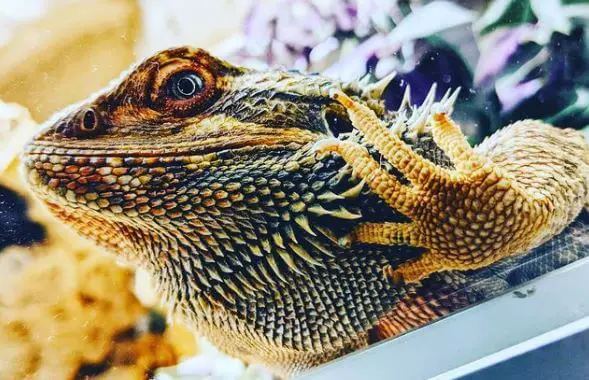
There are some reasons why a bearded dragon misses its nail:
- He might crazily dig something like a hornworm.
- He may have an intense fight with another guy.
- His substrate has some problems.
Many people also ask, “Can bearded dragons eat nails?” That may be a reason as well, but it is relatively rare.
6. How Often to Clip or Trim Bearded Dragon’s Nails?
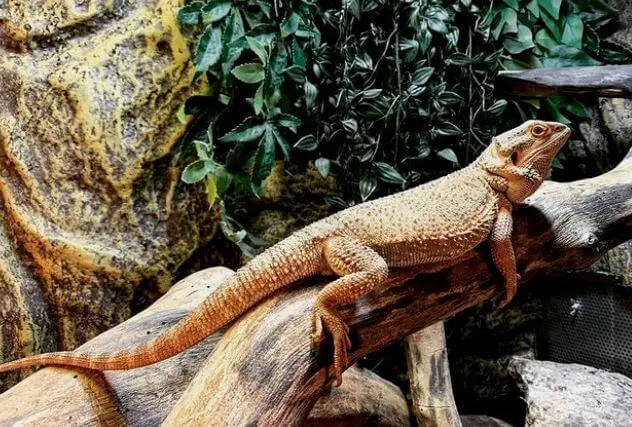
In reality, you should trim your pets’ claws after around four to six months. That is the time when their toenails become too long, which might hurt you and themselves.
I even clip them five to six times a year to avoid my bearded dragon’s nails getting stuck.
7. Can You Paint a Bearded Dragon’s Nails?
If you want to make them more beautiful and memorable, you can paint the tiny claws.
However, bear in mind that it requires time and skill. If not, you might make the little stuff uglier than it used to be.
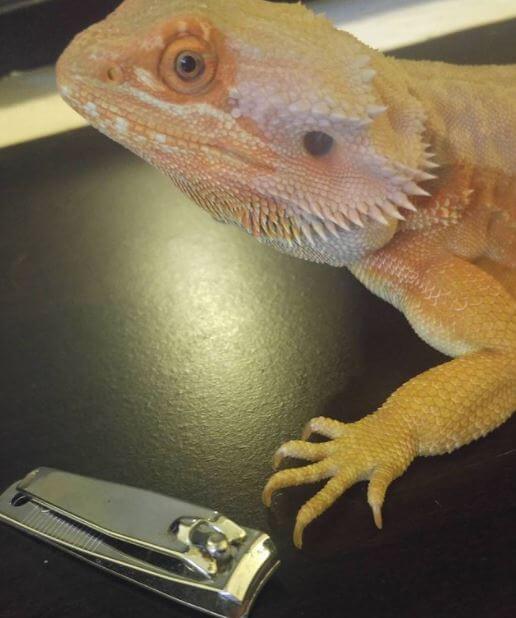
Conclusion
In summary, above are some main pieces of information related to how often to trim bearded dragon nails.
Primarily, you should clip those parts every four to six months. That can be longer, depending on your time and how fast they grow.
We hope the article has helped you take care of your beardies in the best way.
Key points for bearded dragon nail care:
 Regular nail maintenance is an essential aspect of bearded dragon care to ensure their overall health and well-being. Bearded dragons, like many reptiles, need their nails trimmed to prevent overgrowth and potential problems. Here’s what you need to know about how often to trim a bearded dragon’s nails:
Regular nail maintenance is an essential aspect of bearded dragon care to ensure their overall health and well-being. Bearded dragons, like many reptiles, need their nails trimmed to prevent overgrowth and potential problems. Here’s what you need to know about how often to trim a bearded dragon’s nails:
1. Natural Wear:
- In the wild, bearded dragons naturally wear down their nails through digging and climbing.
- In captivity, the nails can become overgrown because they have limited opportunities for these activities.
2. Overgrown Nails:
- Overgrown nails can lead to discomfort, mobility issues, and potential injuries.
- They may hinder the dragon’s ability to grasp, climb, or even eat properly.
3. Frequency of Trimming:
- The frequency of nail trimming can vary depending on the individual bearded dragon.
- On average, trimming is needed every 4 to 8 weeks.
4. Check the Nails:
- Regularly examine your bearded dragon’s nails for signs of overgrowth.
- When they start to curve or look too long, it’s time to trim.
5. Equipment:
- Use a specialized reptile nail clipper or a small, fine-grain nail file to trim the nails.
- Ensure the tools are clean and sharp to avoid splintering the nails.
6. Handling and Restraint:
- Gently hold your bearded dragon to prevent them from moving during the trimming process.
- It’s essential to handle them carefully to avoid stress or injuries.
7. Trimming Technique:
- Carefully trim the tips of the nails, taking care not to cut too close to the quick (the blood vessel inside the nail).
- Trim small amounts at a time to avoid accidental injury.
8. Styptic Powder:
- Have styptic powder or a similar clotting agent on hand in case you accidentally cut the quick.
- Applying it can stop any bleeding quickly.
9. Ask for Help:
- If you are unsure about the trimming process, ask a veterinarian or an experienced reptile owner to show you the proper technique.
- It’s essential to be confident and cautious during nail trimming.
10. Reward and Positive Reinforcement:
- After trimming, offer your bearded dragon a treat or some form of positive reinforcement to reduce stress and create a positive association with nail maintenance.
11. The Alternative:
- If you’re uncomfortable with nail trimming or your bearded dragon is particularly uncooperative, consider using rough surfaces or substrates in their enclosure to naturally wear down their nails.
Regular nail trimming is a vital aspect of bearded dragon care to prevent overgrowth and potential complications. It not only helps maintain their health but also ensures they can move and behave comfortably in their enclosure. By following the appropriate guidelines and techniques, you can safely trim your bearded dragon’s nails and contribute to their overall well-being.
Further Reading:
- Carolina Custom Cages Terrarium Review
- 8 Best Basking Rocks for Beardie: What Is the Best Choice?
- 10 Best Thermometers for Beardie: How to Choose the Best One?
- 5 Best Beardie Lighting Setups for Beardie Lovers
- 9 Best Heat Lamps for Beardie: Natural Habitat Provided

